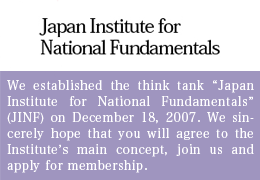CHINA’S AGGRESSIVE EXPANSION SCHEME IN THE EAST CHINA SEA
The New York Times carried on the front page of its April 10 edition images of a number of Chinese ships reclaiming land around Mischief Reef in the Spratly Islands in the South China Sea. On May 20, the US Defense Department flew a P8 reconnaissance plane with a CNN film crew aboard over the area, releasing images globally on the same day and prompting the international community to protest against the illegal Chinese activities. This is a concrete example of how sharing information can significantly influence world opinion.
The Chinese have for some time been performing similar acts of aggression right before our eyes—in the East China Sea, rapidly forging ahead with gas field development and construction of drilling rig platforms along the Japan-China median line. As of November 1998, China had completed gas field development and construction of drilling platforms at four locations—“Shirakaba (called Chunxiao by China)”, “Kashi (Tiangwaitian)”, “Heiko (Pinghu)”, and “Hakkakutei (Bajiaotin).” By June last year, over a 16-year period, two more locations had been added. Then over the past year, six new gas fields were added.
The six new gas fields are: “Kogan (Huangan) 14-1,” constructed very close to the median line;“Kogan (Huangan) 1-1,” southeast of “Heiko (Pinghu)”; “Kogan (Hungyan) 2-2,” directly to the east and close to the median line; “Shoko (Shaoxing),” to the southwest of “Heiko (Pinghu)”; and “Danketsutei (Tuanjiting)” and “Danketsutei (Baoyunting)” to the northeast of “Hakkakutei (Bajiaotin).”
These facilities, all marked by towering drilling rigs, are complete with what look like three-story dormitories for the workers, refineries, and heliports.
The Chinese have rushed ahead with their South China Sea reclamation activities in defiance of strong criticism from the international community. Obviously, the Chinese felt now was the time to act—in the absence of any sign on the part of President Obama that he had the will to intervene. Why have the Chinese rushed to complete these additional drilling platforms in the East China Sea very near the median line? Any chance they assumed the Japanese government would not react?
Japan and China have long disputed each other’s claims to gas fields in the East China Sea. At stake are an esimated 200 billion cubic meters of natural gas reserves. While Japan has maintained that the Japan-China median line is the boundary line, China has claimed the areas stretching from the Chinese coast to the Okinawa Trough as its sovereign territory. China asserts it can only agree to joint gas field development if the area is limited to between the median line and the Japanese EEZ (exclusive economic zone), maintaining that China alone can develop gas fields in all of the area west of the median line. China reasons that while it claims almost the entire East China Sea as its own, Japan only claims sovereignty over the area up to the median line: therefore, the two nations should only dispute their territorial rights over the area between the median line and the EZZ.
Forward Base for Contingency involving Japan
Indignant about the Chinese claim, Shoichi Nakagawa, who was Japan’s Minister of Economy, Trade and Industry in 1995, pushed ahead with an undersea resource survey in an area stretching from the EEZ to close to the median line—a survey which had not been undertaken by Japan until then. The survey ascertained that the Kashi/Tianwaitian and Shirakaba/Chunxiao gas fields—as well as the Asunaro/Lonjing and Kusu/Duanqiao fields which then were on the Chinese drawing board—were connected with the Japanese territories under the sea. All of the present Chinese gas fields, including those newly completed or already in operation, are within the same area. There is a high possibility that our precious undersea resources are being siphoned off by China.
On July 14, 1995, Nakagawa granted Teikoku Oil Co., Ltd. exploration rights. However, exploration never started as Toshihiro Nikai, a pro-China law maker named Nakagawa’s successor in a cabinet reshuffle in 2005, declared he was against it. Japan has since made no efforts to develop gas fields in the East China Sea.
What has recently been brought to light is that China has been accelerating extraction of gas in the East China Sea, especially over the past year.
There are those in the government agencies and ministries concerned who say that Japan is in no position to raise questions because the Chinese are engaged in gas development in areas just inside the median line. That type of thought process is exactly what causes one to turn a blind eye to these Chinese acts of aggression, significantly hampering our national interests. What Japan must urgently do is to ascertain the real intent of China’s sudden increase in development in this area. If the Chinese really are aiming at developing gas fields in the East China Sea, then we must remind them that their gas fields spread across the Japanese EEZ, strongly protesting against their arbitrary conduct.
We are naturally concerned about the economic as well as military aspects of this sudden Chinese development scheme. Experts point out that the drilling platforms built in the East China Sea can rather easily be converted to military use, just like the man-made islets in the South China Sea. Two years ago, Chinese PLA helicopters took off from and landed on platforms on the reclaimed islands. Today one should take note of the fact that the Chinese are very intent on the use of drones. The drilling platforms in the East China Sea are ideally located as forward bases against Japan for drones and rotorcraft.
The Chinese facilities fit snugly into a 60-kilometer circle around the point of intersection at 29 degrees north latitude and 125 degrees longitude. If the Chinese were to install radar and other facilities in the heart of the circle, they would be able to monitor every type of communication within a radius of 500 kilometers, enabling them to grasp the movements of the Japan Self Defense Forces and the US forces across Okinawa and the Nansei Islands. At present, the range of China’s radar networks installed on its coastal areas can barely cover the Senkaku Islands, barring the Chinese from sufficiently engaging in warning and surveillance as well as information-gathering activities. If China managed to install radar devices near the median line, its information-gathering ability vis-a-vis Japan would be dramatically enhanced.
Also, if sonars were to be attached to buildings below sea level, the movements of submarines could readily be detected.
Deterrence against Acts of Aggression
On July 1 the US Joint Chiefs of Staff announced The National Military Strategy of the United States of America, defining China, Russia, Iran, and North Korea as “potentially hostile” nations—“revisionist nations” upsetting the international norms of treaties and laws. For the first time in recent years, the US positioned China as a potentially hostile nation on a par with Russia and Iran—proof that China’s expansionism is creating friction and tensions within the international community.
And yet, a group of facilities usable to acquire both undersea resources and military information has been completed by China very near the median line without most of us knowing anything about it. Can such an arbitrary act be permissible? Japan’s National Security Council (NSC) must have pertinent information about this issue. Why doesn’t it make such information public? Do our government officials think it is not such a serious matter for Japan?
On June 30, China announced it had completed its South China Sea reclamation project. Almost unquestionably, the Chinese will use the newly built man-made islets to claim sovereignty over both the land and the surrounding sea. After all, the Chinese have always claimed that almost all of the South China Sea belongs to them. And they will most likely make similar claims in the East China Sea.
China is reverting to a 19th-century style imperialism, ready to wrest by force anything it wants. Japan is supposed to have established the NSC in order to cope with such a situation. Hasn’t Prime Minister Shinzo Abe been pushing his proactive diplomacy—determined to “take a panoramic perspective of the world map,” as his office likes to describe it—in order to strengthen our deterrence against China’s aggression?
Now that the US—which Japan has long expected to function as its security shield—apparently is losing its spirit under President Obama, we find ourselves in a position in which we must safeguard our national interests by enhancing our national strength. In order for all the people of Japan to share a common security awareness and prompt the Diet to move forward deliberations on the proposed security legislation as quickly as possible, it is imperative that we share information concerning the Chinese threat under our very noses.
Without coming to grips with the realities of the abominable Chinese expansion in the South China Sea, it will be next to impossible to defend our gas fields in the East China Sea from the Chinese threat.
(Translated from “Renaissance Japan” column no. 663 in the July 16 issue of The Weekly Shincho)








